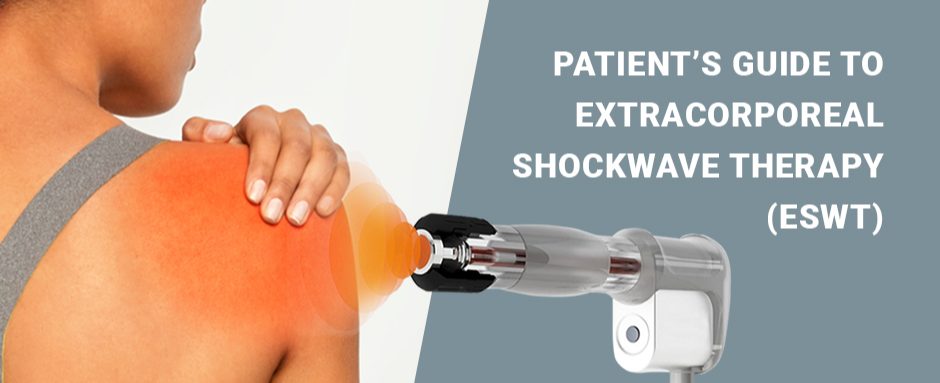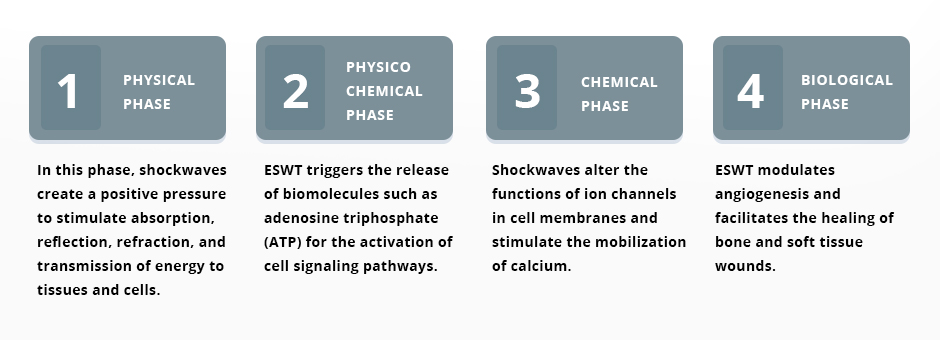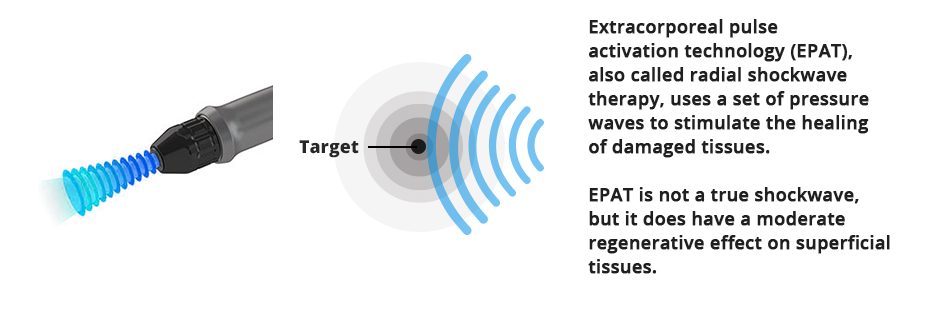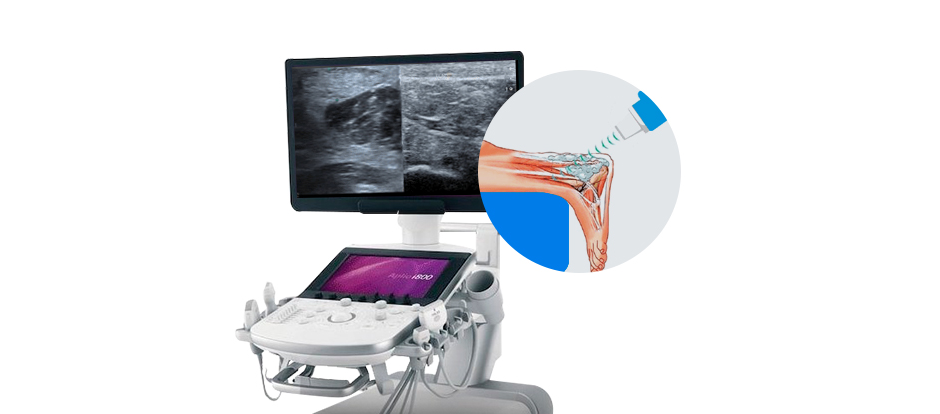
Advances in technology have permeated almost every aspect of modern life, frequently making old ways of doing things obsolete. When it comes to musculoskeletal pain and dysfunction, regenerative technologies are taking center stage as successful alternatives to drugs and surgery.
Extracorporeal shockwave therapy (ESWT) is an evidence-based regenerative technology that has its roots in kidney stone treatment, but has evolved to encompass a broad range of treatment use cases. Learn about the history of ESWT and its rise to super stardom as an effective treatment for pain, movement disorders and injury rehabilitation.
The impact of shockwaves on human tissue was first realized during the second world war, when it was discovered that acoustic waves from water explosives impacted the lung tissue of soldiers without harming other body tissues. This piqued the interest of researchers, and led to further investigation into the impact of shockwaves on humans, funded by the German Department of Defense.
Scientists began exploring the potential use of shockwaves for healing human tissue in the 1960s and 70s. It wasn’t until the 1980s that ESWT began to be used to break up kidney and gall stones in a procedure called lithotripsy. This marked the advent of non-invasive technologies for in-vivo treatment of human tissues.
In its early stages, concerns that the use of shockwaves to break up kidney stones could potentially harm patients’ hip and pelvic bones led to research on the impact of shock waves on bony tissue. Researchers soon discovered that shockwaves have an osteogenic effect on bone that can activate osteoblasts, to stimulate and accelerate the healing of fractures. An orthopedic shockwave device was soon developed to treat bone non-unions and stress fractures.
By the 1990s, research was being done to explore the effectiveness of shockwave therapy in the treatment of a broad range of conditions, and it was discovered that shockwaves have a regenerative effect on tendon tissue and other soft tissues.
Shockwaves are now commonly used to treat:
Tendinopathies
Bone stress fractures
Bone edema
Avuncular necrosis
Myofascial pain
Cosmetic procedures
Wound care
Erectile dysfunction
Spasticity management
A host of other orthopedic conditions

Shockwave therapy is also used to treat coronary disease, and it is used intraoperatively during open heart surgery. Its potential for treating neurodegenerative disorders like Parkinson’s disease and cerebral palsy is currently being explored, and showing great promise.
As the number of use cases for ESWT grows, the equipment has become more sophisticated, and the use of shockwaves to treat human tissue has become more widespread. In many cases, extracorporeal shockwave therapy provides a superior alternative to surgery.
Regenerative therapies are used to treat a broad range of musculoskeletal conditions. They use energy waves to induce physical reactions in the body’s cells that cause them to adapt and regenerate.
ESWT uses a series of low-energy acoustic waves that are transmitted to the patient’s skin via a transducer, with a topical gel as a medium. It is completely non-invasive, and does not require anesthesia or pain medications.
Shockwaves work by triggering the body’s innate healing mechanisms to stimulate tissue repair and reduce pain. Many patients report significant pain reduction after a single treatment session.
Because ESWT triggers an inflammatory response, which is the body’s mechanism for healing, patients may experience temporary swelling and tenderness at the treatment site. This is a positive healing response that should not be suppressed with anti-inflammatory medications.
Until recently, the precise mechanisms of shockwave therapy were somewhat of a mystery, but it is now hypothesized that ESWT affects both cells and the interstitial spaces surrounding them in four distinct phases:

In this phase, shockwaves create a positive pressure to stimulate absorption, reflection, refraction, and transmission of energy to tissues and cells.
ESWT triggers the release of biomolecules such as adenosine triphosphate (ATP) for the activation of cell signaling pathways.
Shockwaves alter the functions of ion channels in cell membranes and stimulate the mobilization of calcium.
ESWT modulates angiogenesis and facilitates the healing of bone and soft tissue wounds. Additionally, it appears that cavitation increases the permeability of cell membranes and the ionization of biological molecules.
The underlying hypothesis of ESWT aligns with the principles of mechanotransduction: Mechanical load applied to the cytoskeleton stimulates cellular responses, leading to an increase in protein biosynthesis.
While the mechanisms of ESWT in alleviating pain remain somewhat unclear, it is hypothesized that:
Shockwaves cause the degeneration of nerve fibers from small immunoreactive neurons, decreasing pro-inflammatory mediators.
Shockwaves trigger the release of endorphins and other analgesic molecules.
There are two main types of shockwave therapy that are often used together to optimize treatment outcomes:

Extracorporeal shock wave therapy (ESWT), also known as focused shockwave therapy, is the most regenerative type of shockwave treatment, estimated to be up to 70% more effective than radial shockwaves. Focused shockwaves allow for greater precision, to within a single millimeter of targeted tissue. The depth of penetration can be varied, to reach both superficial and deep tissues.
Despite its precision, focused shockwave therapy is best performed under ultrasound guidance, and the clinician must be highly trained and experienced in the use of musculoskeletal ultrasonography. For that reason, focused shockwave therapy is slightly more expensive than radial shockwave therapy.
Extracorporeal pulse activation technology (EPAT), also called radial shockwave therapy, uses a set of pressure waves to stimulate the healing of damaged tissues. EPAT is not a true shockwave, but it does have a moderate regenerative effect on superficial tissues. EPAT shockwave therapy is effective for repairing superficial muscle tissue, and it makes a good companion to focused shockwave therapy.

For focused shockwave therapy to be most effective, it is important for the shockwaves to precisely penetrate their target. Shockwave therapy is the gold standard for regenerative therapies, yielding platinum results when performed under ultrasound guidance by an experienced clinician.
Because the structures of the musculoskeletal system are all interdependent, a problem in one area often affects multiple structures. For example, a non-traumatic tendon issue may cause dysfunction at the myotendinous junction, myofascial pain and stiffness, altered muscle firing patterns, and joint instability. Many structural changes can occur in structures distant from the locus of pain.
Diagnostic ultrasonography performed in conjunction with ESWT by an experienced practitioner can dramatically improve the likelihood of successful long-lasting outcomes. Combining different types of shockwaves can help to reduce pain and restore pain-free function. Ultrasound guidance helps the clinician to calculate the perfect energy, frequency, and volume of pulses, and select the appropriate type of shockwaves, based on the characteristics of the injury.
Research shows that shockwave therapy is about 80-90 % effective, depending on the type of lesion being treated. However, most research is done using only a single type of shockwave. In our experience, holistic ESWT using different types of shockwaves can deliver 100% efficacy, in many cases eliminating the need for additional therapies.

The clinic at NYDNRehab features the highest resolution ultrasound equipment available for diagnosis and treatment of fractures, tendinopathies, and soft tissue injuries. In addition to rendering crisp and clear images, our equipment enables us to test tendon elasticity via elastography, and to detect early signs of tissue healing via superb microvascular imaging (SMI).
Dr. Kalika’s expertise and years of experience with ultrasonography ensures that your focused shockwaves hit their mark. We then follow up with SMI to confirm that healing is in fact taking place. Ultrasonography takes the guesswork out of shockwave therapy, increasing its efficacy while minimizing patient discomfort.
Dr. Kalika is an active member of the American Institute of Ultrasound in Medicine (AIUM), and is currently developing his own unique approach to Dynamic Functional Ultrasonography. He has also co-authored multiple scientific papers on the use of shockwave therapy for a variety of musculoskeletal conditions. His proven track record of rehabilitating sports injuries and restoring pain-free function makes NYDNRehab the clinic of choice for ESWT in NYC.
As the use of extracorporeal shockwave therapy becomes more widespread, the number and types of conditions that are successfully treated are growing.

Shockwave therapy is particularly effective in treating tendon problems such as plantar fasciitis, shoulder tendinopathy, elbow tendinopathy, patellar tendinopathy and Achilles tendinopathy. In addition to its regenerative effects, ESWT stimulates the production of lubricin, a mucinous glycoprotein that facilitates tendon gliding. One recent study of 384 patients with tendinopathies found that shockwave therapy significantly reduced pain and improved function and quality of life.
Myofascial pain can occur when areas of the thin tough sheath of tissue that surrounds and separates muscles and vital organs become taught and develop trigger points. ESWT is highly effective in eliminating trigger points, relieving pain and restoring myofascial function.
Osteoarthritis is caused by the breakdown of joint cartilage and its underlying bone over time, resulting in pain and stiffness in the affected joint. Shockwave therapy does not stimulate the production of new cartilage, but it does effectively relieve pain in the early stages of OA.
Research has shown ESWT to improve symptoms and functional outcomes in patients suffering from carpal tunnel syndrome. It is recommended that the underlying cause of neuropathy be addressed as part of the treatment protocol.
Shockwave therapy that combines focused and radial shockwaves renders excellent results in the treatment of sciatic nerve pain. It can also positively affect the facet joints of the spine, and relieve myofascial trigger points that often contribute to back pain.
Other Conditions Successfully Treated with Extracorporeal Shockwave Therapy:
Pelvic pain
Nerve entrapment
Fascial disorders
Scars
Bone edema
Bursopathies
Stress fractures
Tibial stress syndrome
Fibrocartilage lesions
Ligament injuries
Low back and neck pain
Early osteoarthritis
Myositis ossificans
Fibromyalgia

ESWT is often used in conjunction with other therapies and treatment methods to optimize patient outcomes.
Regenerative technologies like extracorporeal shockwave therapy are still relatively new to the realm of rehabilitative medicine, and the vast majority of physical therapists are either unaware of their benefits, or not sufficiently qualified to use them.
Dr. Kalika and the team at NYDNRehab are always on the lookout for new ways to provide the best patient care, to rehabilitate injuries, eliminate pain and resolve movement disorders.
In addition to ultrasound guided shockwave therapy, our clinic features a growing array of advanced technologies that accelerate the healing process with minimal patient discomfort. To get the very best treatment for your condition, contact NYDNRehab today.
Resource
Best practices for extracorporeal shockwave therapyin musculoskeletal medicine: Clinical applicationand training consideration. Link.
Crevenna, Richard, et al. “Focused extracorporeal shockwave therapy in physical medicine and rehabilitation.” Current Physical Medicine and Rehabilitation Reports 9.1 (2021): 1-10.
Dedes, Vasileios, et al. “Effectiveness and safety of shockwave therapy in tendinopathies.” Materia socio-medica 30.2 (2018): 131.
Gesslbauer, Christina, et al. “Effectiveness of focused extracorporeal shock wave therapy in the treatment of carpal tunnel syndrome.” Wiener klinische Wochenschrift 133.11 (2021): 568-577.
Zhang, Qing, et al. “Efficacy of extracorporeal shockwave therapy on pain and function in myofascial pain syndrome of the trapezius: a systematic review and meta-analysis.” Archives of physical medicine and rehabilitation 101.8 (2020): 1437-1446.
Dr. Lev Kalika is a world-recognized expert in musculoskeletal medicine. with 20+ years of clinical experience in diagnostic musculoskeletal ultrasonography, rehabilitative sports medicine and conservative orthopedics. In addition to operating his clinical practice in Manhattan, he regularly publishes peer-reviewed research on ultrasound-guided therapies and procedures. He serves as a peer reviewer for Springer Nature.
Dr. Kalika is an esteemed member of multiple professional organizations, including: